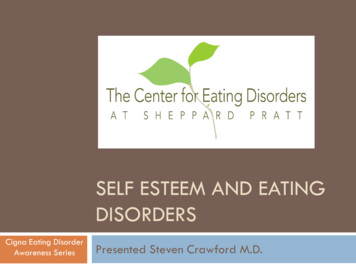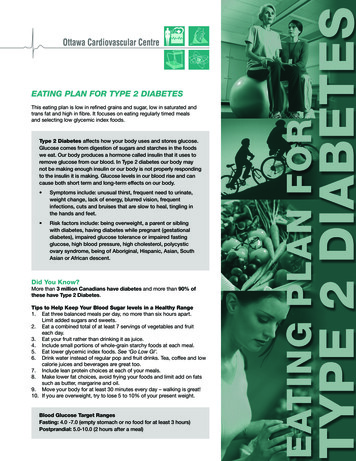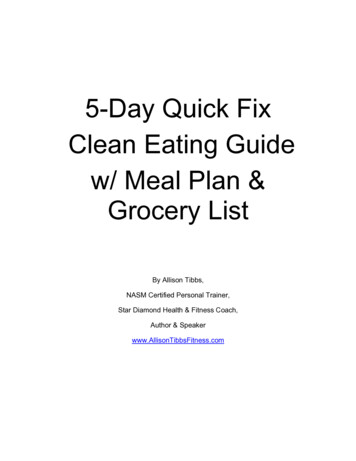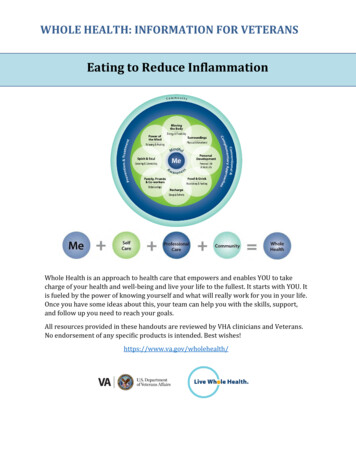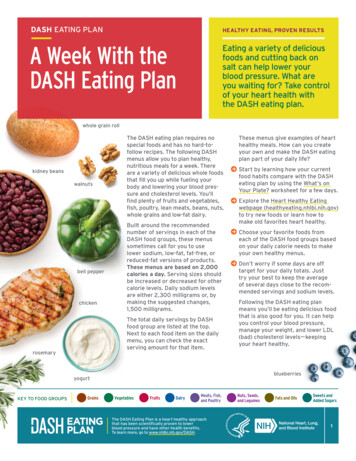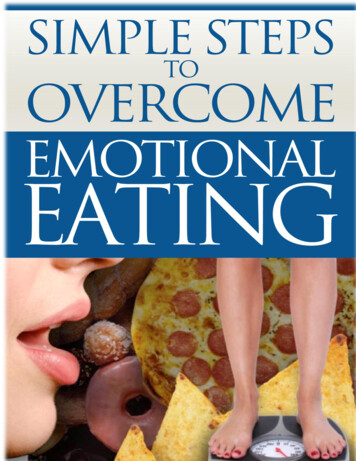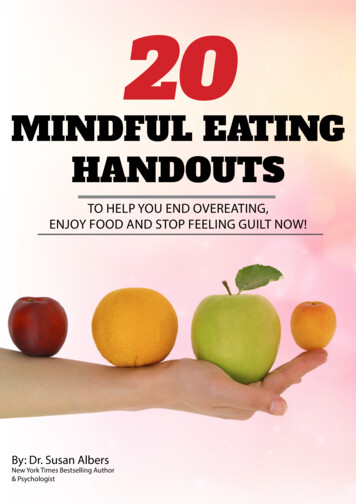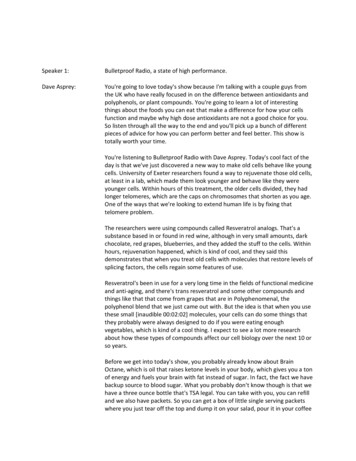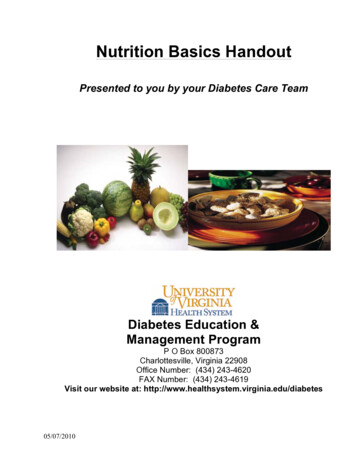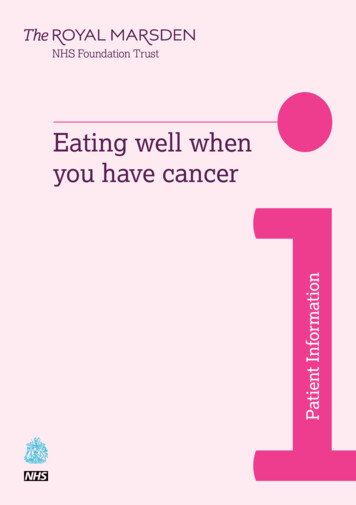
Transcription
iEating well whenyou have cancer
Eating well when you have cancerContentsIntroduction 5Nutrition chart Food hygiene 78Problems that can affect eating 9Poor appetite 10Tiredness 11Nausea 12Sore mouth or throat 13Dry mouth 14Changes in taste 15Unpleasant tastes 15Bland tastes 16Feeling full very quickly 17Alteration in bowel habits 19Diarrhoea 20Constipation 20Weight loss 21Nourishing drinks Prescribed supplement drinks Specialist supplements Ideas on how to use supplements Meal and snack ideas 2323242425Recipes 27Savoury choices Sweet options Drinks recipes 283335Frequently asked questions 37 Returning to a normal diet 43The Eatwell plateNotes and questions4445
Introduction5
Eating well when you have cancerIntroductionCancer and the side effects of treatment can affect yourappetite and weight.This booklet will give you some advice on how to adaptyour diet. It is based on a combination of the best evidenceavailable and suggestions from patients.The foods we eat contain a range of different nutrients. It is important toeat foods with all of these nutrients each day.The nutrients play specific roles in maintaining good health. These aredescribed in the table opposite.Much of the information in this booklet is aimed at people who arestruggling to eat and have lost weight. You will find that we recommend alot of high energy (calorie) and high protein foods in these circumstancesto help you increase your energy intake and maintain your weight.Some types of chemotherapy encourage people to gain weight duringtreatment. If this happens to you then follow the advice for a balanced dietand include the high energy foods in small amounts. The tips on eatingwell when you have taste changes, tiredness or nausea may be helpful ifyou experience any of these symptoms.NutrientFunctionFoods high in this nutrientCarbohydrates Provides energy and isStarchy – rice, potatoes, pasta,(Carbs)usually categorised as starchy bread, chapatis, roti, bulgarand sweet .wheat.Sweet – sugar, honey, agave,chocolate, biscuits, cake,boiled sweets.ProteinForms the building blocks ofmuscles and organs such asthe liver and heart.Beans, lentils, meat, fish,eggs, quinoa, milk, Quorn ,tofu, nuts.EnergyThis supports life. It is oftendescribed in terms suchas our metabolism andmovement/physical activity.If we do not eat enoughenergy the body breaks downits own tissues to supply this.All foods high incarbohydrates, proteinand fat.FatProduction of healthy braintissue and hormones.Carrier for fat solublevitamins.Is used for energy.Vegetable oils, butter,margarine, ghee, nuts, seeds.FibreRegulates bowel function and Wholegrain foods, brown rice,promotes bowel healthwholemeal bread and flour,beans, lentils, nuts.Fruit and vegetables containsome fibre but less than theother foods listed.6FluidMaintains hydration.All drinks (except alcohol),foods with a high watercontent.Vitamins andmineralsHelps the body to function,regulating metabolism,growth and repair.All foods including fruit andvegetables.7
Food hygieneWhen you are ill or are having cancer treatments you aremore likely to get food poisoning. To help protect yourselffrom food borne organisms it is important to follow goodhygiene and you should also avoid particular foods.PreparationProblems thatcan affect eating Wash your hands thoroughly with soap and warm water before cooking, aftertouching the bin, going to the toilet, and before and after touching raw food Wash all worktops and chopping boards before and after cooking Use different chopping boards for raw and ready-to-eat foods Keep raw food away from ready-to-eat foods such as bread, salad and fruit Store raw meat in a clean, sealed container on the bottom shelf of the fridge Wash fruit and vegetables under cold running water before you eat them When cooking check that food is piping hot throughout before you eat itFoods to avoidWe recommend that these foods are avoided because they are associated withan increased risk of listeria, campylobacter, salmonella and toxoplasmosis Uncooked soft cheeses with white rinds e.g. Brie, chevre (goats cheese) Uncooked blue cheeses e.g. Gorgonzola, Roquefort, and Stilton Pâté – meat, fish and vegetarian Raw and undercooked meat Raw shellfish Unpasteurised milk Raw and partially cooked eggs89
Eating well when you have cancerPoor appetiteTirednessThere can be many reasons why people lose their appetitewhen they have cancer. In some cases the cancer itself cansuppress your appetite. For others it may be related to theside effects of the treatment or medication they are receiving.Some may be anxious about what might happen in thefuture. Whatever the reason, these suggestions may help.Many patients find that they are too tired or don’t have theenergy to prepare or cook foods.Many people find it easier to take small frequent snacks throughout theday rather than sticking to their usual three meals a day. This might alsobe referred to as a ‘little and often’ approach.A very full plate of food may put you off eating – try using a smaller plateto help keep the portions small. You can always go back for more if youcan manage it.Accepting offers of help with shopping and cooking from relatives canreally help to lift the burden. It may be helpful to prepare food in advancewhen you do feel like cooking rather than leaving it to individual mealtimes.Frozen meal delivery services such as meals on wheels, Wiltshire FarmFoods, Oakhouse Foods and other companies that make prepared foodscan be very helpful, ask your nurse or dietitian for further information.Online shopping can also be a good way of getting your usual foodswithout having to go out.Ideas that can help:Try to eat the most when your appetite is at its best. For many patientsthis is in the morning – why not try a cooked breakfast or porridge? Make use of convenience food and ready made mealsDon’t eat too much low energy but filling foods such as clear soups,vegetables and fruit. Make use of snacks that do not require much preparation.See ideas on page 25Some people find that alcoholic drinks such as sherry or a glass of winebefore a meal can help perk up their appetite. Remember to check with thedoctor or pharmacist that this is allowed if you are taking medication. Having a nourishing drink may be easier than eating a meal.See ideas on page 35 and 36 Plan ahead and keep stocks of these in your cupboard or freezerChoose easy to eat foods – many people find softer foods like scrambledeggs, stews, pasta and desserts easier than drier meals like sandwiches,roast dinners, pizza and steak.It can be more difficult to think of things you would like to eat when yourappetite is poor, even if your family and friends are prepared to give youanything you wish. It may be easier for them to simply prepare meals theyknow you have eaten in the past. Or the ideas for meals and snacks onpage 25 might help if you have run out of inspiration.There are a few medicines that may improve your appetite; however theydo have side effects. Ask your doctor, nurse or dietitian if they would besuitable for you.1011
Eating well when you have cancerNauseaSore mouth or throatNausea is a particularly difficult side effect to manage withdiet. This may be a side effect of medication or treatment.Radiotherapy and chemotherapy can cause a sore mouthor throat. This problem can be made worse by infection,for example, thrush or by problems with your teeth ordentures.There are a large range of anti-sickness (antiemetics) medicines available.Ask your doctor or nurse which would be suitable for you.Changing the type of foods you opt for at mealtimes may help.Avoid strong smells as these often make nausea worse.Try not to sit in a stuffy room, fresh air can help.If you have a sore mouth or throat contact your doctor or nurse who canprescribe medication to help.Ideas that can help:Ideas that can help: Cold foods or foods at room temperature usually smell less than hotfoods – try tinned fruit, biscuits, dry toast, yoghurt, cereal, ice creametc. You may be able to eat a main meal if you allow it to cool downto room temperature, as this will reduce the smell Sucking boiled sweets, fruit sweets and mints may be helpful Try soft foods. It may help to use extra sauces and gravy withyour food Avoid alcohol, particularly wines and spirits that will irritatesore areas Try to drink nourishing drinks in addition to food (see page 35 and 36) Dry toast or ginger biscuits may help to settle your stomach Avoid rough or textured foods such as mince and cereals which canget caught in sore areas; smooth foods will slip down more easily Remember to drink plenty. Some people find sipping fizzy drinkssuch as ginger ale or soda water helpful. Try herbal teas that containginger Avoid very hot foods; try warm, cool or frozen foods and drinks tosee which temperature is most comfortable Avoid greasy foods as they can make nausea worse Try to eat small amounts of food throughout the day, little and often,rather than having large meals Anxiety can make nausea worse so try to make meals as calm andrelaxed as possible12 Avoid sharp or spicy foods which will irritate sore areas e.g. curry,chillies, pepper, tomato sauces, oranges and other citrus fruits,vinegar and crisps If you like soups choose creamy smooth (blended) ones such ascream of chicken, Meritene or Complan soups. See page 23 for waysof increasing the energy and protein in soups. Let the soup coolbefore trying13
Eating well when you have cancerDry mouthChanges in tasteRadiotherapy to the mouth, some chemotherapy andpainkillers can lead to a dry mouth. When your mouth isdry you are at an increased risk of getting infections suchas oral (mouth) thrush, and tooth decay, which will makeeating harder.There are many reasons why sense of taste can change,for example chemotherapy, radiotherapy, medication andsometimes the cancer itself can affect taste sensation.If you have a dry mouth you will probably also havetaste changes.Ask your doctor or nurse about mouthwashes and medication that mayreduce the chance of you getting mouth thrush. Artificial saliva andpastilles are available and may provide useful relief of a dry mouth.Ask your doctor or nurse about mouthcare, especially if your mouth feelscoated or your saliva seems thicker than normal.Ideas that can help: Try to sip cool drinks frequently to help moisten your mouth.It will help if those drinks contain energy or protein – e.g. milkshakes,milky drinks, fizzy drinks, fruit juices, and fruit squash (hot or cold).Sucking ice cubes may also helpIf the food affected is one that you eat occasionally then avoid thatparticular food until taste returns however if it is a food you have often youwill need to find an alternative e.g. have hot fruit squash or milk instead oftea and coffee. Try herbal teas but remember if you are losing weight addsugar or honey to increase energy content. If meat starts to taste metallicthen have more eggs, chicken, fish or cheese. Try soft moist foods that have sauces, gravy, custard, cream orsyrups with themIf you dislike the flavour of salty foods try sweeter foods instead. If savouryfoods are difficult then eat more desserts and cake. However if you areavoiding a lot of foods ask to see a dietitian for more advice. Avoid sticky, chewy and dry foods such as bread, cold meat,and chocolateUnpleasant tastes Try dipping foods such as bread, crackers and biscuits into liquidssuch as tea, coffee or milk to make them easier to swallow Some people find sucking sweets, sugar free chewing gum or eatingcitrus fruits helps you produce saliva. Take care with strong citrusflavours if your mouth is soreThis can be due to medication you are taking or totreatment but it would be sensible to see your oralhygienist to make sure it’s not caused by a problemwith your teeth or gums.Ideas that can help: Try sucking sugar free fruit sweets or mints to mask the taste Concentrate on the foods that you can manage most easily1415
Eating well when you have cancerBland tastesFeeling full very quicklySometimes food may taste ‘like cardboard’ or have notaste at all. This is often associated with extreme dryness.Many people find that they feel full long before completingtheir meal. This often happens when you haven’t beeneating well, have had surgery or are receiving treatment.Try to avoid getting constipated as this can makematters worse.Ideas that can help: Choose foods that are highly flavoured and try to increase the flavourand aroma of your food using spices, marinades, pickles etc. If youhave a sore or inflamed mouth, speak with your dietitian beforehaving very spicy or acidic foods Add textures to your food, such as, crushed crisps over savourydishes or sprinkle chopped nuts on desserts. This may be difficultif your mouth is too dry after treatment Combine different temperatures together – e.g. hot fruit pie and coldice cream If eating food is very difficult then supplement drinks will be usefulto ensure you get the nutrition you need. Speak to your dietitian ordoctor regarding this16Ideas that can help: Small frequent snacks throughout the day are often easier than a fullmeal. Some people find it helpful to leave a gap between their maincourse and pudding or eat meals in two sittings Choose high energy products or enrich your food with high energyproducts (see page 22 and 23) Avoid drinking lots of fluid before you eat, as this can make you feelfull much more quickly Sit up straight at meal times if you can Avoid lying down straight after eating. You may find a short walk aftereating makes you feel more comfortable17
Alteration inbowel habits1819
DiarrhoeaDiarrhoea may be due to your illness, treatment or medication. Talk toyour doctor or nurse who will try to work out the cause of your diarrhoeaand give any necessary medication.Weight lossIdeas that can help: Drink plenty of fluids to avoid becoming dehydrated. Aim for10–12 glasses or cups each day. Remember fluids include milkand milkshakes, fruit juices, soup, custard and jelly as well as tea,coffee and water Look out for the symptoms of dehydration. These are passing urineless often and passing small amounts of dark coloured urine If these symptoms persist despite your best efforts to drink more,then contact your doctor. This is especially important if you are alsovomiting Eat small amounts frequently (see page 25 and 26 for ideas for snacks) Ask your dietitian, doctor or nurse if you need to change your dietConstipationConstipation may be due to the cancer, treatment, poor fluid intake ormedication (especially painkillers). If you are very constipated you mayfeel full and suffer from nausea or sickness.The advice for constipation is often to increase the intake of dietary fibrebut this does not have the desired effect when the constipation is not dietrelated. Talk to your doctor or nurse about suitable laxatives.Ideas that can help: Drink plenty of fluids, at least 10–12 glasses or cups each day Try to take gentle exercise2021
Eating well when you have cancerWeight lossWeight loss can be a challenging problem. It may be oneof the symptoms you had at the time of your diagnosis orit may have developed during or after treatment. Weightloss can change the way you see yourself and this canbe distressing.Weight loss can have a negative impact on your treatment as well asyour mobility and general strength and stamina. It is not always possibleto gain the weight you have lost but you may be able to prevent furtherweight loss.If you have a poor appetite then trying to gain weight by eating more foodwill be very difficult. You may be able to adjust the foods you eat instead,choosing those naturally higher in energy or by enriching foods.Ideas that can help: Use ordinary meat/mince rather than a lean choice Add extra cheese to pizza, white sauces, soups, pasta and vegetablesand extra paneer to curries Add ground nuts, nut butters i.e. peanut butter, cashew nut butteror full fat coconut milk to curries Avoid replacing a meal with soup, as it does not have as muchnourishment as a meal or snack. If you really fancy soup then alwaysenrich it with some of the ideas mentioned below Add cream, sour cream, plain yoghurt, coconut yoghurt, mascarponecheese or crème fraiche to sauces, soup and meat dishes Use evaporated milk, condensed milk or cream (pouring or whipped)to top desserts, cakes or hot drinks Add nuts, seeds, golden syrup, jam or cream to porridge and milky puddings Use extra honey, sugar or syrup with cereal, drinks, fruit and desserts Have cream, ice cream or soya ice cream (frozen non-dairy dessert)with desserts Use fortified milk on food, in drinks and when cooking (a recipe isprovided on page 35)Nourishing drinks Use a full fat, full sugar variety where it is available e.g. yoghurts,custard, squash and avoid what may be labelled as ‘lighter’ choicesfor foods like bread, biscuits, cake bars, crisps etcA high energy drink can be a good choice if you have a poor appetite.They can be milky or fruity, home made or bought from the supermarket.There are also drinks which can be prescribed by your GP or medicalteam, ask to discuss this with a dietitian if you think these are required. Add extra vegetable oil, butter or margarine to potatoes, bread, sweetpotatoes, pasta, rice, chapatis, rotis, noodles and cooked vegetables Add a generous spread of nut butter, i.e. peanut butter, cashew nutbutter, honey, chocolate spread, lemon curd, jam or marmalade tobread, toast, crackers or biscuits Enrich suitable sandwich and jacket potato fillings with mayonnaise,crème fraiche or soured cream. Savoury dips can also add extra energy Have salad with mayonnaise or oil based dressings Use mayonnaise or aioli with foods such as chips or jacket potato22Prescribed supplement drinksThese drinks are specially formulated to be higher in energy and proteinthan drinks you can buy in the shops. In addition many also containthe same range of vitamins and minerals found in a varied diet. They areavailable in different styles (milkshake, juice and yoghurt), volumes andflavours. They should only be taken if recommended by a dietitian, nurseor doctor and your use of these should be closely monitored.You may be given an initial sample pack or hospital prescription but if yourequire a regular supply this must be provided by your GP on prescription.23
Eating well when you have cancerSpecialist supplementsA dietitian or other health care professional may recommend that youtake a supplement rich in one particular nutrient such as carbohydrate, fator protein in addition to other drinks or dietary advice. They often comeas low volume liquids or powders and may be flavoured or unflavoured/neutral. These should be used under supervision and only to the doserecommended. You may be provided with a small supply via the hospital ora sample service initially but a regular supply will be provided by your GP.Some ideas on how to use themMost of the supplements whether bought or prescribed can be adapted tochange their taste. This may make them more appealing especially if youhave been taking them for a while. Most companies produce recipes whichare usually found online these will give you some extra ideas. Chill sweet flavoured drinks or heat them gently (do not boil) Add ice cream (dairy/non-dairy), syrups or fresh fruit and blend tomake a smoothie. Adding soaked oats or nuts before blending canadd an interesting textureFortified milk can be used to make tea, coffee, lattes and hot chocolate.Higher energy drinks can be bought from local supermarkets andpharmacies such as Nurishment, Weetabix on the go, Complan andMeritene. Some are ready to drink and simply need to be chilled or heateddepending on your preference. Others are powders which need to bemixed with milk or water and can be sweet or savoury. To maximise theenergy from these they are best mixed with full fat milk.Nourishing smoothies can be made by mixing fresh, frozen or tinned fruitwith a combination of fruit juice, milk, ice cream or yoghurt with oats andseeds. (See page 35 and 36 for some ideas).Meal and snack ideasSome people find that when they have a poor appetite it can be difficult tothink of foods they want to eat. When ideas are presented, it can be easierto make a choice about what to eat. The foods marked with a * are suitablefor people following a soft diet.Below is a selection of meals and snacks that are high energyand protein. Add fruit juice, fizzy water or soft drinks such as lemonade to juicestyle drinks French toast (bread dipped in beaten egg and fried) Freeze them into ice cream or ice-lollies. Take ice cream out of thefreezer 10-15 minutes before eating it Pancakes with fruit and syrup Make a high energy jelly by replacing some of the water in the recipewith a juice style supplement Unflavoured supplements can be used to enrich liquid foods such assoup, custard and yoghurt or stirred into puree consistencies such asmashed potato, carrots, swede etc Warm chocolate, coffee or vanilla flavoured drinks. Add whisky orbrandy to make a delicious hot toddy Croissants and other breakfast pastries *Full fat yoghurt or coconut yoghurt with muesli, cereal, fresh fruitand sugar. Add extra toppings of honey or chocolate sprinkles *Fruit smoothies (blend fruit, milk and yoghurt) *Shepherds or cottage pie – this can be meat or vegetarian *Cauliflower or macaroni cheese Snacks on toast – *baked beans or *tinned spaghetti with an *egg or*cheese grated on top *Scrambled or poached egg, *Omelettes – cheese, ham, tomatoor Spanish2425
*Dhal with chapatis or rice Thai green or red curry with basmati rice Chicken or potato and channa curry with rotiRecipes Cheese & crackers Samosa, patties, spring rolls Crisps, nuts, seeds, Bombay mix Biscuits – shortbread, chocolate, cream filled, flapjacks, chocolatecaramel slice *Ice cream, *custard, *rice pudding *Crème caramel, *panna cotta Cake, fruit pies, cheesecake Muffins or crumpets (sweet or savoury), toasted teacake or scone,doughnut, Danish pastry Fried dumplings/bakes with ackee and saltfish or fried plantain,doubles, coconut drops, tamarind balls Satay (chicken, meat or vegetarian), mini pork pies, scotch eggs *Pasta with sauces – pesto, cheese, carbonara, bolognese, creamytomato sauce *Jacket potatoes with beans, cheese, tuna, chilli, sausage stew Stir fried meat, fish, Quorn , nuts or tofu with vegetables.Serve with rice or noodles2627
Eating well when you have cancerRecipesWhen going through treatment, cooking can becomedifficult. Tiredness and lack of appetite can make cookingunappealing. Cooking in advance or using the freezer tostore food can help. It can also be cost effective and meana varied diet is more easily achieved.These are easy recipes that family or friends can make for you.sharp knife – they should at this point be tender. Add a splash of waterif everything seems too dry.3. Rub the skin side of the fish fillets with the olive oil and season.Place, skin-side up on top of the potatoes and fennel. Bake for 10-15minutes depending on the thickness of your fish fillets.4. Serve immediately with any buttery juices over and the rest of the herbssprinkled on top.The following recipes have been included to give you some ideas.They have been kindly donated by Waitrose and The Royal MarsdenCancer Cookbook published by Kyle books. As with all recipes thesecan be adapted depending on personal preference.One pot roast fish with fennelIngredients:500g new or salad potatoes halved1 large bulb of fennel cut into 8 wedges150ml white wine or waterSmall bunch of parsley finely chopped25g unsalted butter4 thick fish fillets – salmon works well1 tbsp olive oilSalt and black pepperZest of 1 unwaxed lemonServes 4Energy: 364kcal, 22g protein, 19.3g fat (5.7g saturated) 1.7g fibre1. Preheat oven to 200 C/ gas mark 6. Bring a large saucepan of water tothe boil and add the potatoes, fennel and a pinch of salt. Return to theboil and simmer for about 5-6 minutes until starting to soften.Drain thoroughly.2. Put the potatoes and fennel in a roasting dish and spread out evenly.Pour over the white wine, half the parsley and the lemon zest and givea quick stir to combine everything. Dot over the butter and seasonwith salt and pepper. Put in the oven and bake for about 30 minutes,checking regularly to make sure nothing is catching. When thevegetables have taken on a light golden-brown colour, test with a2829
Eating well when you have cancerAutumnal butternut squash lasagneIngredients:1 butternut squash about 1.3kg peeled,100g plain flourdeseeded and cut into 2cm cubes1.1litres full-fat milk2 tbsp olive oilFreshly grated nutmeg350ml veg or chicken stock250g no-precook lasagne sheets100g unsalted butter170g firm mozzarella cheese grated8 fresh sage leaves plus extra to50g parmesan cheese finely gratedgarnishSalt and black peppersquash puree, then sprinkle with a quarter each of the mozzarella andparmesan. Repeat the layering twice more, then ladle on the remainingwhite sauce and dollop the lasagne with the squash puree. Sprinklewith the remaining mozzarella and parmesan and garnish with a fewsage leaves. Dot the remaining 30g of butter on top. Cover the lasagnetightly with foil and bake for 40 minutes. Remove the foil and bake fora further 20 minutes until golden and bubbling.Serves 8Energy per portion: 506kcal, 17g protein, 30g fat (17g saturated), 3.8g fibre1. Preheat the oven to 200 C/ gas mark 6. Line the baking tray withfoil. Put the squash on the tray and drizzle with the oil. Toss well andseason. Roast for around 30 minutes until soft. Transfer to the foodprocessor with the stock and blend until smooth.2. Grease 23x 33cm baking dish with butter, reduce the oven to190 C/ gas mark 5.3. Melt 70g butter in a large saucepan over a medium heat. Twist andbruise the sage leaves to release their flavour and drop into the butter,stirring, flipping and bruising the leaves with a wooden spoon untilthey are crisp but the butter has not yet browned. Using a slotted spoontransfer the sage leaves to a plate and set aside.4. Sprinkle the flour over the butter and stir over a medium heat for about2 minutes until they are well combined and the flour has cooked a little.Slowly pour in the milk whisking constantly. Return the sage to thesauce, bring to the boil whisking constantly then reduce to a simmerand cook for 15 minutes. Stir every few minute to make sure the saucedoesn’t catch on the bottom of the pan. Check for seasoning and add alittle grated nutmeg.5. Ladle a thin layer of the sage cream sauce on the base of the buttereddish. Lay four lasagne sheets in the dish, layering slightly. Addanother ladleful of sauce to cover the pasta, top with a quarter of the3031
Eating well when you have cancerSweet optionsHam and cheese bread puddingIngredients:Butter softened for spreading100ml single cream½ day-old French baguette cut on the150ml milkdiagonal into 5mm slices½ teaspoon salt50g good-quality smoked ham dicedBlack pepper to taste75g gruyere cheese gratedGrated nutmeg200g spinach or chard well washed3 spring onions finely chopped2 large free range eggsRaspberry ripple lolliesIngredients:150g fresh or frozen raspberries1 x 500g pot creamy MadagascanJuice of ½ lemonvanilla custard25g caster sugar200g condensed milkServes 6Energy: 306kcal, 5.8g protein, 14.8g fat (8.7g saturated) 0.6g fibreServes 4Energy: 432kcal, 21g protein, 22g fat (12g saturated fat) 3.6g fibre1. Place the raspberries, lemon juice and sugar in a small saucepan andsimmer for 15 minutes.1. Preheat oven to 180 C/ gas mark 4. Lightly butter a shallow 1 litrebaking dish.2. Pass the raspberry mixture through a sieve and set aside – there shouldbe around 75ml puree.2. Lightly butter the baguette slices. Line the baking dish with half thebaguette slices butter side down. Arrange the ham, half the cheese andthe spinach or chard over the bread. Top with the remaining baguetteslices, butter side-up and sprinkle with the remaining cheese.3. Mix the custard with the condensed milk until combined.3. Beat together the eggs, cream and milk, adding the salt and pepperto taste.4. Pour a tablespoon of the custard into the bottom of your lolly moulds,then add a teaspoon of the raspberry puree and drag a knife or skewerthrough the mixture. Alternate the custard and puree dragging eachtime as before, to get a ripple effect. Place a wooden stick into eachmould and freeze overnight before serving.4. Grate in a little nutmeg, add the spring onions and beat again. Pour theegg mixture into the baking dish, pushing down to submerge the breadif necessary. Bake for about 45 minutes until the custard is set but stilla bit jiggly and the top is nicely browned.Tip: this is a good all rounder providing protein, calcium, iron, beta-caroteneand vitamin E. Serve with tomatoes or red peppers roasted with basil andolive oil for extra vitamins. Waitrose3233
Eating well when you have cancerBanana and coconut bread and butter puddingIngredients:10 slices sliced brioche loaf40g butter, softened100g demerara sugarDrinks recipes3 medium eggsFortified milk400ml can coconut milkIngredients:2 large bananas thinly sliced40g desiccated coconut200ml whole milk2 tbsp dried milk powderServes 6 – 8Energy: 168kcal, 11.7g protein, 10g fatEnergy: 413kcal, 8.6g protein, 24.6g fat (17.8g saturated fat), 2.5g fibreFor extra nourishment, other foods could be added to the milk to changethe taste and improve energy content including:1. Preheat over to 180 C/gas mark 4. Lightly butter the brioche and cuteach slice into two triangles. 1 pot creamy yoghurt2. Set aside 2 tablespoons of the sugar then whisk the remainder with theeggs until light and foamy. Stir in the coconut milk and whole milk untilwell blended. 1 banana or 3 pineapple rings3. Line the base of a large oven proof dish with a third of the slices ofbread and top with some of the banana slices. Repeat until the breadand
The foods we eat contain a range of different nutrients. It is important to eat foods with all of these nutrients each day. The nutrients play specific roles in maintaining good health. These are described in the table opposite. Much of the information in this booklet is aimed at people who are


